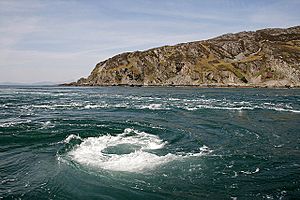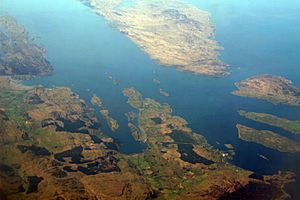Gulf of Corryvreckan facts for kids

The Gulf of Corryvreckan is a famous narrow stretch of water in Scotland. It's located between the islands of Jura and Scarba, off the west coast. The name "Corryvreckan" comes from the Gaelic words Coire Bhreacain, which mean "cauldron of the speckled seas."
This gulf is known for its powerful tidal race, which is like a very strong current. It's so famous that tourists can visit it by boat trips from nearby towns or even by sightseeing flights!
Contents
What Makes the Water So Wild?
The Gulf of Corryvreckan has very strong currents from the Atlantic Ocean. The seabed here is also quite unusual. These two things together create a super intense tidal race in the channel.
When the incoming tide rushes into this narrow area, it speeds up a lot, reaching about 8.5 knots (which is about 16 km/h). The water then hits different features on the seabed. There's a deep hole and a tall, rising rock formation. These features combine to create huge whirlpools, standing waves, and other wild effects on the water's surface.
The Corryvreckan is actually the third largest whirlpool in the world! It forms around a pyramid-shaped rock that rises from about 70 meters deep to only 29 meters below the surface. When the tide is strong, the waves in Corryvreckan can be more than 30 feet (9 meters) high! The loud roar of this powerful water can be heard up to 10 miles (16 km) away.
Even though it's very powerful, the Royal Navy doesn't officially say the Corryvreckan is impossible to sail through. However, a nearby area called the Grey Dogs (or Little Corryvreckan) *is* considered unnavigable. A guide for sailors calls the Corryvreckan "very violent and dangerous." It also warns that "no vessel should then attempt this passage without local knowledge." Expert scuba divers have even called it "potentially the most dangerous dive in Britain."
Legends of the Whirlpool
The Gulf of Corryvreckan is part of many old Scottish stories.
The Winter Goddess
In Scottish mythology, there's a winter goddess called Cailleach Bheur. People believed she used the gulf to wash her great plaid (a type of blanket or cloak). When she did this, it marked the change from autumn to winter. As winter got closer, she would use the gulf as her giant washing machine. It was said that the roar of the coming storm could be heard 20 miles away for three days! After she finished washing, the cloth would be pure white. This white cloth then became the blanket of snow that covered the land.
King Breacan's Story
Another legend is about a Norse king named Breacan. In some stories, he tied his boat near the whirlpool to impress a local princess. In other versions, he was trying to escape from his father across the gulf. In both stories, Breacan was pulled into the whirlpool. His dog later found his body washed ashore. It's possible that the whirlpool was named after Breacan, or maybe its current name is a clever pun on his name in Gaelic.
A Look Back in Time
The Corryvreckan has been known for a very long time.
Early Writings
In the 7th century, a writer named Adamnan wrote about Corryvreckan, calling it "Charybdis Brecani." In his book about St Columba, Adamnan wrote that the saint knew by magic about a bishop who got into trouble in the "whirlpool of Corryvreckan." However, Adamnan said this whirlpool was near Rathlin Island. This might mean his geography was a bit off, or that a different place was originally called Corryvreckan. Later, the name might have been given to the current Corryvreckan.
In 1549, a man named Dean Monro wrote about the area. He said that between the islands of Skarbay and Duray, "there runs a stream, above the power of all sailing and rowing, with endless dangers, called Corybrekan." He also noted that this stream was eight miles long and could only be used at certain times.
Famous Incidents
In 1820, the world's first passenger paddleship, the PS Comet, was wrecked near Craignish Point. This happened because of the very strong currents in the area.
The famous writer George Orwell and his three-year-old son once had a small shipwreck in the gulf. They were boating near the whirlpool and ended up briefly stuck on a small island called Eilean Mòr. Interestingly, Orwell's brother-in-law, Bill Dunn, was the first person known to swim across the gulf!
Animals and Plants of the Gulf
Even with the fast-moving water, many creatures live in the Gulf of Corryvreckan. Minke whales and porpoises swim in these strong currents. Only the toughest plants and corals can survive on the seabed.
You can find soft corals like Alcyonium digitatum in sheltered spots. The main rock pinnacle in the whirlpool is covered with thick mats of tiny animals called hydroids, like Tubularia indivisa. Other small creatures like Securiflustra securifrons also live there. The most exposed areas are home to barnacles such as Balanus crenatus.
This special area is currently being considered for a "Special Area of Conservation" status. This means it would be protected to help its unique wildlife thrive.
See also
 In Spanish: Golfo de Corryvreckan para niños
In Spanish: Golfo de Corryvreckan para niños


